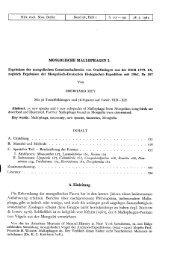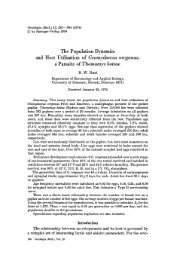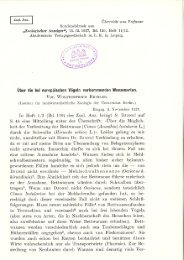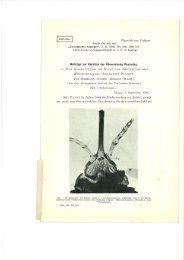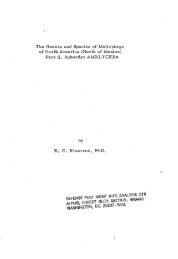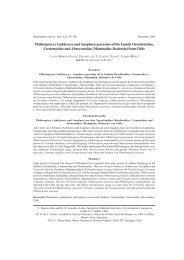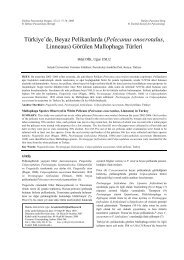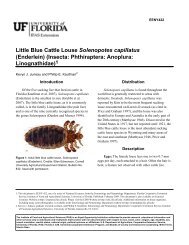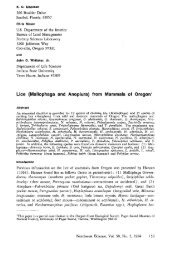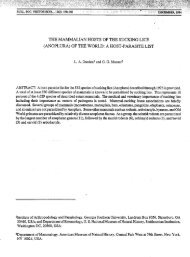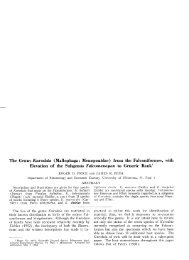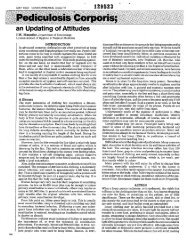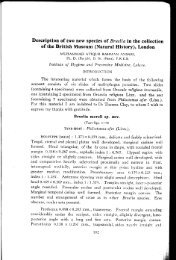The Geographical and Ecological Distribution of Arboreal Psocoptera
The Geographical and Ecological Distribution of Arboreal Psocoptera
The Geographical and Ecological Distribution of Arboreal Psocoptera
Create successful ePaper yourself
Turn your PDF publications into a flip-book with our unique Google optimized e-Paper software.
Annu. Rev. Entomol. 1985.30:175-196. Downloaded from arjournals.annualreviews.org<br />
by Mr. Bas van Berkum on 10/10/07. For personal use only.<br />
Annual Reviews<br />
www.annualreviews.org/aronline<br />
176 THORNTON<br />
<strong>Ecological</strong> Role<br />
FEEDING AND BIOMASS Although usually designated as scavengers or detritivores<br />
when ecological roles are assigned to the various components <strong>of</strong><br />
ecosystems, arboreal <strong>Psocoptera</strong> are in fact grazers, <strong>and</strong> their pastures are the<br />
microepiphytes (fungi, algae, <strong>and</strong> lichens) that grow on the bark <strong>and</strong>. leaves<br />
trees <strong>and</strong> shrubs <strong>and</strong> in the litter. Some also take pollen grains. <strong>The</strong> peculiarities<br />
<strong>of</strong> psocid mouthparts <strong>and</strong> the massive clypeal muscles may in the future be<br />
shown to be specifically related to this grazing type <strong>of</strong> feeding. <strong>The</strong> ecological<br />
importance <strong>of</strong> psocopterans in forest ecosystems has until recently been either<br />
neglected or assumed to be small. However, considerable information is now<br />
available on their role in temperate <strong>and</strong>, to a lesser extent, tropical forest<br />
ecosystems as a major component <strong>of</strong> the guild <strong>of</strong> microepiphyte feeders.<br />
In temperate forests the primary productivity contribution <strong>of</strong> microepiphytes<br />
may be comparable to that <strong>of</strong> the herb layer (92), <strong>and</strong> grazing psocids may make<br />
up a significant part <strong>of</strong> the biomass. Densities <strong>of</strong> over 4000/m2 on the bark <strong>of</strong><br />
larch (Larix decidua), equivalent to over 6000/m2 <strong>of</strong> l<strong>and</strong> surface, have been<br />
recorded in Yorkshire, Engl<strong>and</strong>, during late summer (16). <strong>The</strong> peak biomas s<br />
two species <strong>of</strong> Mesopsocus was about 1.2g/m2 <strong>of</strong> ~ bark surface, or about 2g/m<br />
<strong>of</strong> ground surface. This is comparable to the biomass <strong>of</strong> various kinds <strong>of</strong> big<br />
game animals such as antelopes feeding on grassl<strong>and</strong>s, <strong>and</strong> at peak times the<br />
grazing <strong>of</strong> microepiphytes by psocids can be very intense.<br />
In the tropics, psocid densities are much lower. However, in an altitudinal<br />
transect <strong>of</strong> canopy arthropods from sea level to 2400 m subtropical Hawaii<br />
(26), psocids were frequent <strong>and</strong> abundant on the two dominant trees examined<br />
<strong>and</strong> outnumbered all other taxa combined at mid <strong>and</strong> high elevations. Clearly,<br />
psocid populations can be important primary consumers <strong>and</strong> saprophages.<br />
PREDATION " In Britain a polyphagous mite <strong>of</strong> the genus Anystis is frequently<br />
recorded as a predator <strong>of</strong> psocids. In Yorkshire it may be responsible for much<br />
<strong>of</strong> the high mortality <strong>of</strong> first instar larvae <strong>of</strong> Philotarsus picicornis besides<br />
causing significant egg mortality in Mesopsocus species (23).<br />
In southern Engl<strong>and</strong>, spiders, mites, opilionids, neuropteran larvae, anthocorids,<br />
earwigs, <strong>and</strong> carabids have been reported to attack egg batches <strong>of</strong><br />
foliicolous psocids. Some 26 predators have been recorded (15, 99): the most<br />
important are spiders (by far), mites, opilionids, neuropteran larvae, <strong>and</strong><br />
coccinellid beetle. Of the three major groups <strong>of</strong> epiphyte herbivore:s on larch,<br />
the majority <strong>of</strong> predators select <strong>Psocoptera</strong> <strong>and</strong> Homoptera rather than the<br />
numerically more abundant Collembola.<br />
Ants (Crematogaster sp.) in Brazil have been seen at night attacking <strong>and</strong><br />
carrying <strong>of</strong>f archipsocids that live under large communal sheet-webs. In Florida<br />
archipsocids are preyed upon by Argentine ants <strong>and</strong> reduviid bugs.



